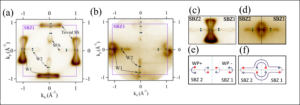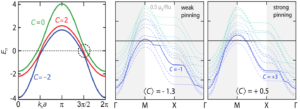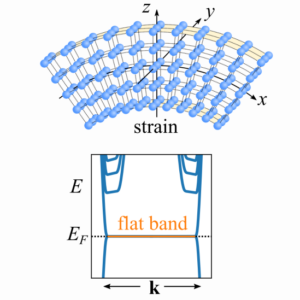Revealing and functionalizing interfacing effects is in the heart of MagTop’s activities, and brought a number of surprising developments in the case of topological crystalline insulators with gapless 2D and 1D Dirac states at the surface, as described in other highlights. MagTop’s studies demonstrated that deposition of heavy metals Pb and Nb on the surface of Weyl semimetal NbP strongly affects non-topological surface states and displaces arches connecting Weyl points, substantiating a theory of the topological Lifshitz transition [G. E. Volovik, Low Temp. Phys. 43, 47 (2017)] .
 |
NbP is a representative example of Weyl semimetals (WSM), in which the linearly dispersing singly degenerate bands cross at discrete points, referred to as Weyl points (WP). As shown in Figure, the surface projections of WP pairs with opposite chirality are connected by surface Fermi arcs (SFA) that coexist with non-topological (trivial) bowtie-like surface states (SS), which are modified by Pb deposition.
In contrast to doping with light elements K and Se [H. F. Yang, L. X. Yang, Nat. Commun. 10, 3478 (2019); A. Bedoya-Pinto et al., Adv. Mater. 33, 2008634 (2021), respectively], deposition of Pb or Nb on the P-terminated surface affected little the carrier density but, as found for K, led to the disappearance of the bowtie-like surface states and to reconstruction of surface Fermi arches (see Figure), i.e., to the topological Lifshitz transition. For Nb-terminated NbP covered with 1.9 ML of Pb, an ordinary Lifshitz transition occurred with unchanged topological surface Fermi arches but with the appearance of additional trivial pockets. Deposition of Nb on the Nb-terminated NbP surface led to a formation of a disordered system with blurred features poorly resolved in the APRES results.
[1] A.S. Wadge, B. J. Kowalski, C. Autieri, P. Iwanowski, A. Hruban, N. Olszowska, M. Rosmus, J. Kołodziej, and A. Wiśniewski, Topological Lifshitz transition in Weyl semimetal NbP decorated with heavy elements, Phys. Rev. B 105, 235304 (2022).
Charge transfer that appears at the interface of ultrathin itinerant Weyl ferromagnet SrRuO3 and polar insulator LaAlO3 exceeds capacities of ordinary electrostatic gates. MagTop’s theoreticians, after determining the Chern numbers for a SrRuO3 monolayer, showed that such interfacial doping affects the Berry curvature, and in an extreme case leads to a change of the sign of the Hall conductivity below Curie temperature [2]. This effect is due to a conversion of the Chern numbers of partially occupied bands, i.e., due to topological reconstruction in the momentum space, occurring in the presence of both strong or weak charge pinning (redistribution) in the Weyl metal layer.
 |
Three-dimensional SrRuO3 is an itinerant ferromagnet that features Weyl points acting as sources of emergent magnetic fields, anomalous Hall conductivity, and unconventional spin dynamics [S. Itoh et al., Nat. Commun. 7, 11788 (2016)]. We demonstrated that ultrathin SrRuO3 exhibits spin-polarized topologically nontrivial bands at the Fermi energy (Figure) [1]. Their band anticrossings show an enhanced Berry curvature and act as competing sources of emergent magnetic fields. We found that symmetric structures (SrTiO3/SrRuO3/SrTiO3 and SrIrO3/SrRuO3/SrIrO3) exhibit an interface-tunable single-channel anomalous Hall effect, while ultrathin SrRuO3 embedded in asymmetric structures (SrTiO3/SrRuO3/SrIrO3) shows humplike features consistent with multiple Hall contributions. The band topology of two-dimensional SrRuO3 proposed by us accounts for these observations and harmonizes a large body of experimental results.
Other systems, in which a surprising behaviour of the anomalous Hall conductivity was found are heterostructures consisting of ultrathin SrRuO3 and LaAlO3, a polar wide-band-gap insulator [2]. Here, in agreement with our model (see Figure), the sign of the anomalous Hall effect depends on the magnitude of the charge transfer between the layers, which determines the actual band bending at the interface and, thus, the sign and value of the Berry curvatures for particular bands [2].
[1] D. J. Groenendijk, C. Autieri, T. C. van Thiel, W. Brzezicki, J. R. Hortensius, D. Afanasiev, N. Gauquelin, P. Barone, K. H. W. van den Bos, S. van Aert, J. Verbeeck, A. Filippetti, S. Picozzi, M. Cuoco, A. D. Caviglia, Berry phase engineering at oxide interface, Phys. Rev. Research 2, 023404 (2020).
[2] T. C. van Thiel, W. Brzezicki, C. Autieri, J. R. Hortensius, D. Afanasiev, N. Gauquelin, D. Jannis, N. Janssen, D. J. Groenendijk, J. Fatermans, S. Van Aert, J. Verbeeck, M. Cuoco, A. D. Caviglia, Coupling Charge and Topological Reconstructions at Polar Oxide Interfaces, Phys. Rev. Lett. 127, 127202 (2021).
invited talks: W. Brzezicki: „Superconductivity and Functional Oxides, SUPERFOX 2020„, „Topological Quantum Science 2021, TQS2021„, „Oxide Superspin 2021, OSS2021„, „Oxide Superconducting Spintronics Workshop 2022, OSS2022„, „Superstripes 2022„, „Electronic Correlations, Emergent Phenomena, and Quantum Materials Workshop – Lectiones Amalfitanae 2022
Topologically non-trivial materials exhibit a variety of extraordinary transport phenomena affecting both charge and heat flow. The latter is considered to be more robust to experimental artefacts that may appear in electrical measurements [D. Vu et al., Nat. Mat. 20, 1525 (2021)]. MagTop’s Weyl group found novel effects in thermal conductivity, the chiral zero sound and the gravitational anomaly, in two different Weyl semimetals: NbP and NdAlSi.
Among the novel phenomena exclusive to Weyl semimetals is the chiral zero sound (CZS) effect [Z. Song and X. Dai, Phys. Rev. X 9, 021053 (2019)], named after the zero sound effect appearing in a Fermi liquid due to the oscillating deformation of the Fermi surface. Alternatively, CZS can occur in semimetals with multiple pairs of Weyl points, and it is supposed to provide an additional channel for chargeless heat transfer [J. Xiang et al., Phys. Rev. X 9, 031036 (2019)]. This effect must lead to a violation of the Wiedemann – Franz (WF) law that assumes a fixed ratio between the charge and heat fluxes. We investigated the low-temperature thermal transport in the Weyl semimetal NbP, where magnetic-field dependencies of the thermal conductivity showed pronounced quantum oscillations with the amplitude about two orders of magnitude larger than could be expected from the WF law [1]. Moreover, the oscillations of the electrical and thermal conductivity were in antiphase with each other (see Figure). The CZS phenomenon appears explaining the origin of these new effects.
Another non-trivial characteristic of Weyl semimetals is the occurrence of quantum anomalies, which are the breakdowns of classical conservation laws that occur in quantum–field theory description of a physical system [N.P. Ong, and S. Liang, Nat. Rev. Phys. 3, 394 (2021)]. This includes the chiral anomaly, which is a violation of the chiral current conservation that takes place when a Weyl semimetal is subjected to parallel electric and magnetic fields. A charge pumping between Weyl points of opposite chirality causes the chiral magnetic effect that has been extensively studied with electrical transport. On the other hand, if the thermal gradient is applied along the magnetic field, then as a consequence of the gravitational anomaly an energy pumping occurs within a pair of Weyl cones. This pumping is expected to generate anomalous heat current contributing to the thermal conductivity. Indeed, we reported an increase of both magneto-electric and magneto-thermal conductivities in NdAlSi [2], indicating that the gravitational anomaly can be detected in a semi-classical regime with the Fermi level not matching exactly the position of the Weyl points.
[1] P.K. Tanwar, M.S. Alam, M. Ahmad, D. Kaczorowski, and M. Matusiak, Severe violation of the Wiedemann-Franz law in quantum oscillations of NbP, Phys. Rev. B 106, L041106 (2022).
[2] P.K. Tanwar, M. Ahmad, M.S. Alam, X. Yao, F. Tafti, and M. Matusiak, Gravitational anomaly in antiferromagnetic topological Weyl semimetal NdAlSi, arXiv:2305.04650
Surprising physics of magnetic topological materials and possible applications in sensors, metrology, computing, and catalysis [B. A. Bernevig et al. Nature 603, 41 (2022)] have triggered experimental and computational search for compounds with robust topological functionalities coexisting with or brought about by a magnetic order. In particular, high-throughput first-principles calculations, implementing the density functional theory (DFT) within the generalized gradient approximation (GGA)+Hubbard U, indicated that 130 compounds out of 430 magnetic materials studied have topological phases when scanning U [Y. Xu et al., Nature 586, 702 (2020)]. MagTop’s researchers called those results into question demonstrating that more computationally demanding approaches are necessary to properly identify topological classes and, in particular, explain the experimentally observed band gap in EuCd2As2 and its red shift in a magnetic field.
Motivated by recent optical experiments [1], MagTop’s team revisited first-principle results obtained earlier for EuCd2As2 and extended the computational studies to the whole class of systems EuCd2X2 (X = P, As, Sb, Bi), to EuIn2X2 (X = P, As, Sb), and to nonmagnetic AEIn2As2 (AE= Ca, Sr, Ba) employing a hybrid functional method [2]. The results indicated that EuSn2As2, EuCd2Bi2, EuCd2SbBi, and BaIn2As2 are robust topological materials (see, Figure for some examples), while all other compounds are topologically trivial semiconductors, not Weyl semimetals, as claimed so-far. Actually, the topologically trivial Eu-based systems are antiferromagnetic semiconductors with a strong red shift of the energy gap in a magnetic field caused by the exchange coupling of the band states to spins localized on the 4f-shell of Eu ions. Additionally, the EuIn2X2 (X = P, As) compounds show altermagnetic exchange-induced band spin-splitting, particularly noticeable in the case of states derived from 5d-Eu orbitals.
[1] D. Santos-Cottin, I. Mohelský, J. Wyzula, F. Le Mardelé, I. Kapon, S. Nasrallah, N. BarišIć, I. Živković, J. R. Soh, F. Guo, M. Puppin, J. H. Dil, B. Gudac, Z. Rukelj, M. Novak, A. B. Kuzmenko, C. C. Homes, T. Dietl, M. Orlita, A. Akrap. EuCd2As2: a magnetic semiconductor submitted to Phys. Rev. Lett. (2023); arXiv:2301.08014.
[2] G. Cuono, R. M. Sattigeri, C. Autieri, and T. Dietl. Ab-initio overestimation of the topological region in Eu-based compounds, submitted to Phys. Rev. B Letters (2023); arXiv:2305.10804.
Invited talk: C. Autieri “International Conference on Crystal Growth and Epitaxy” to be held in Naples, Italy, from 30 July to 4 August 2023. Title of the talk: “Design of new topological materials”. See also the website: https://www.iccge20.org/
After explaining how the flat band in twisted graphene can carry a non-zero supercurrent, MagTop’s theoreticians demonstrated that strain engineering can be used to generate quasi-flat three-dimensional energy bands in materials known as topological nodal-line semimetals, thereby paving the way to tunable correlated phases in three-dimensional materials. Superlattices based on HgTe can constitute a practical realization of that concept.
 |
 |
Our study was motivated by the recent discovery of unconventional superconductivity in a twisted pair of graphene sheets, which is a famous consequence of what is known as a flat energy band. In such bands, the kinetic energy of a material’s electrons becomes negligible and their mutual interactions dominate, which gives rise to enhanced correlation effects and exotic phases of matter. Before our discovery, the study of these intriguing phenomena had focused on two-dimensional materials [1] due to the lack of realistic proposals for their three-dimensional counterparts. Our work shows that strained topological nodal-line semimetals fills this gap and opens the door to the study of flat-band physics in three dimensions [2].
We found that the required strain profile can be realized in an experimentally feasible way, for instance, by bending the sample (see Figure), which allows for in-situ tuning of the emerging correlated phases and the transition temperatures. Moreover, we identified rhombohedral graphite and CaAgP materials as promising material candidates to realize this proposal. In a follow-up study, we also showed that HgTe/CdTe superlattices are material systems that may host 3D flat bands without additional doping when fabricated, for instance, as core-shell nanowires [3].
Three-dimensional flat bands may realize novel exotic phases. We therefore looked closer into one of these phases, namely, flat-band superconductivity, which can arise in these materials due to a large geometric contribution to the superfluid weight. We addressed the question of how stable these phases are in the presence of impurities, which are unavoidable in a realistic experimental setting. Our numerical simulations revealed that a flat band superconductor is as resilient to non-magnetic disorder as a conventional superconductor [4]. This finding underlines the feasibility of our approach for the realization of stable correlated phases in three-dimensional materials.
Xiang Hu, T. Hyart, D. I. Pikulin, E. Rossi, Geometric and Conventional Contribution to the Superfluid Weight in Twisted Bilayer Graphene, Phys. Rev. Lett. 123, 237002 (2019), arXiv:1906.07152 (2019)
[1] A. Lau, T. Hyart, C. Autieri, A. Chen, and D. I. Pikulin, Designing three-dimensional flat bands in nodal-line semimetals,Physical Review X 11, 031017 (2021)
[2] R. Islam, B. Ghosh, G. Cuono, A. Lau, W. Brzezicki, A. Bansil, A. Agarwal, B. Singh, T. Dietl, and C. Autieri, Topological states in superlattices of HgTe class of materials for engineering three-dimensional flat bands,Physical Review Research 4, 023114 (2022)
[3] A. Lau, S. Peotta, D. I. Pikulin, E. Rossi, and T. Hyart, Universal suppression of superfluid weight by non-magnetic disorder in s-wave superconductors independent of quantum geometry and band dispersion, SciPost Physics 13, 086 (2022)